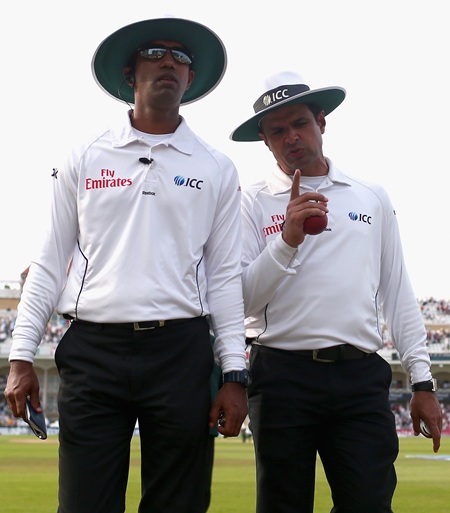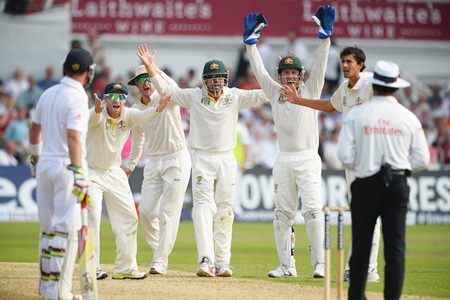Photographs: Ryan Pierse/Getty Images
The International Cricket Council, on Tuesday, revealed the assessment of the umpires, including the Decision Review System analysis, from the Trent Bridge Test between England and Australia.
The umpires made a total of 72 decisions, which is well above the average (49) for a DRS Test match. The umpiring team was assessed to have made seven errors during the match, out of which three were uncorrected decisions and four decisions were corrected using the DRS.
As such, the correct decision percentage before reviews stood at 90.3 per cent but climbed to 95.8 per cent as a result of the use of the DRS. This represented an increase of 5.5 per cent in correct decisions, which was the average increase from DRS Test matches in 2012-13.
The three decisions that were marked as uncorrected errors included one against Jonathan Trott when a correct LBW decision was overturned. The other involved Stuart Broad (catch at slip and LBW not offering a shot) but these couldn’t be corrected as Australia had no reviews available.
'Umpires did a good job under difficult conditions'
Image: Australia players appeal unsuccessfully for the wicket of Stuart Broad on day three of the 1st Ashes Test match at Trent BridgePhotographs: Laurence Griffiths/Getty Images
When coupled with the conditions, with reverse swing and spin playing an important role, and the added intensity of the first Ashes Test, it was a difficult match to umpire.
Reflecting on the assessment, ICC Chief Executive David Richardson said: "The umpires did a good job under difficult conditions. This reflects the calibre of umpires Dar, Dharmasena and Erasmus who have consistently performed at a high level.
"However, like the players, umpires can also have good and bad days but we all know that the umpire’s decision, right or wrong, is final and must be accepted."
'We must continue to strive to improve umpiring and the performance of the DRS'
Image: England's captain Alastair Cook signals for a television reviewPhotographs: Darren Staples/Reuters
"While the ICC has complete faith in the ability of its umpires, our confidence in technology is also strengthened by the fact that there was an increase in the number of correct decisions in the Trent Bridge Test through the use of the DRS.
"Technology was introduced with the objective of eradicating the obvious umpiring errors, and to get as many correct decisions as possible. If it can help increase the correct decisions by 5.5 per cent, then it is a good outcome, but we must continue to strive to improve umpiring and the performance of the DRS," Richardson added.
The statistics from Trent Bridge Test:
Total umpire decisions | 72 |
Correct decision % before review | 90.3% |
Correct decision % after review | 95.8% |
% increase in correct decisions using DRS | 5.5% |
DRS - Reviews by countries
Team | Reviews | Successful | Unsuccessful |
England | 4 | 3 | 1 |
Australia | 9 | *2 | 7 |
Total | 13 | 5 | 8 |
*Of the two successful decisions, Australia had one incorrectly reversed by the TV Umpire.




Comment
article